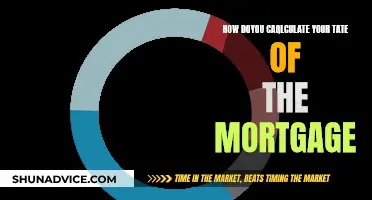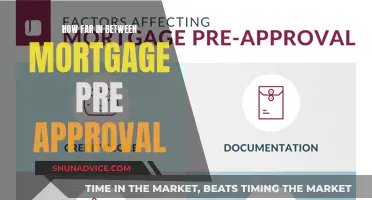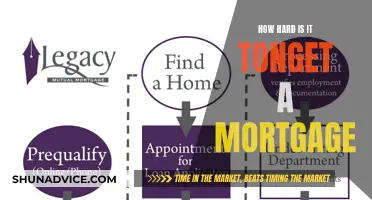
Researching mortgages can be a complex process, but there are many resources available to help you make informed decisions. It's important to understand the type of mortgage you want and your financial situation, including short- and long-term goals. You can use online tools and websites to estimate monthly payments, compare interest rates, and review public mortgage records. Real estate agents can also provide valuable insights and help you produce a fair offer. Choosing the right lender is critical, so be sure to research their history, licensing, and customer reviews. Friends and family can offer referrals, and mortgage brokers can help you secure a great deal, although they typically charge a fee for their services.
What You'll Learn

Types of mortgages
The type of mortgage loan you choose is important and depends on your credit score, finances, and long-term housing plans. Here are the five main types of mortgages:
Conventional Loans
These are the most popular type of mortgage and are offered by private banks. They come in two forms: conforming and non-conforming. Conforming loans meet a set of Federal Housing Finance Agency (FHFA) standards, including guidelines around credit, debt, and loan size. They are eligible to be purchased by government-sponsored enterprises like Fannie Mae and Freddie Mac. Non-conforming loans, on the other hand, do not meet one or more of these standards and are riskier for lenders. One common type of non-conforming loan is a jumbo loan, which exceeds the conforming loan limit.
Government-Backed Loans
These loans are insured by different federal agencies, such as the Federal Housing Administration (FHA), and are designed to make homeownership more accessible. They are best for borrowers with lower credit scores and minimal cash for a down payment. FHA loans, for example, can be obtained with a credit score of 580 and a 3.5% down payment or a score as low as 500 with a 10% down payment. Government-backed loans also include VA loans, guaranteed by the US Department of Veterans Affairs, which are available to eligible military members and their spouses.
Fixed-Rate Loans
With fixed-rate mortgages, your interest rate remains the same for the duration of the loan, usually 15 or 30 years. This option provides stability and predictability in your monthly payments, making it ideal for those who value certainty in their loan costs. However, your total monthly payment can still change due to fluctuations in property taxes, homeowner's insurance, or mortgage insurance.
Adjustable-Rate Loans (ARMs)
Adjustable-rate mortgages offer less predictability but could be cheaper in the short term. They are suitable for borrowers who plan to stay in the home for a shorter period or are comfortable with possible short-term savings and potential long-term costs. During the initial fixed period, your interest rate remains stable, but in the second period, it fluctuates regularly based on market changes, potentially leading to significant increases in your monthly payments.
Jumbo Loans
Jumbo loans are a type of non-conforming conventional loan that allows you to finance a more expensive property. However, they come with more stringent qualifying criteria, higher borrowing costs, and larger minimum down payment requirements. Jumbo loans are typically sought by borrowers with good credit scores looking to purchase a higher-priced home.
Zillow's Mortgage Estimate Secrets: What You Need to Know
You may want to see also

How to qualify for a mortgage
Researching mortgages and qualifying for one are two very different things. While the former has become easier with the advent of the internet and digitization, the latter is a complex process that requires a good deal of financial planning and management.
Qualifying for a mortgage is a multi-step process that requires a borrower to meet certain criteria. Here are the key factors that determine one's eligibility for a mortgage:
Credit Score
A good credit score is essential when it comes to qualifying for a mortgage. The minimum credit score required for a conventional mortgage is typically around 620. However, a score of 780 or higher is preferable, as it can help borrowers secure the best interest rates and lower PMI premiums. It's worth noting that some lenders may consider the average median score of multiple applicants, which can be advantageous for borrowers with lower credit scores.
Down Payment
Most mortgages require a down payment, which is a percentage of the purchase price paid upfront. The down payment requirements vary depending on the type of mortgage. For conventional mortgage loans, the down payment is usually between 10% and 20% of the purchase price. On the other hand, loans backed by the Federal Housing Administration (FHA) often require a minimum down payment of 3.5%, making them more accessible to borrowers with lower incomes or credit scores.
Debt-to-Income Ratio (DTI)
Lenders evaluate an applicant's debt-to-income ratio (DTI), which is the percentage of their gross monthly income that goes towards debt payments. A high DTI ratio indicates that a significant portion of the individual's income is already committed to other debts, which may impact their ability to repay the mortgage. Conventional lenders typically prefer a maximum DTI ratio of 45%, but they may be willing to accept a ratio of up to 50% for borrowers with higher credit scores and additional reserves.
Income Stability and Proof of Income
Lenders also consider the stability and dependability of an applicant's income. Consistent income from salary or wages is generally viewed more favourably than income from tips or commissions, which may be less reliable. Self-employed individuals may be required to provide at least two years' worth of personal and business tax returns to demonstrate stable income. Lenders will also require proof of income, such as federal tax returns or bank statements, to verify that the borrower has the financial means to repay the loan.
Housing Cost Ratio (HCR)
The housing cost ratio, also known as the housing expense ratio, is another important factor. It is calculated by dividing the total mortgage interest, principal, insurance payment, and property taxes by the borrower's gross monthly income. Lenders typically require a HCR of 28% or lower, as it indicates that the borrower is more likely to afford the mortgage payments.
Government-Backed Programs
Various government-backed programs exist to make homeownership more accessible. These programs, such as those offered by the Federal Housing Administration (FHA), U.S. Department of Agriculture (USDA), and U.S. Department of Veterans Affairs (VA), have less stringent requirements than conventional mortgages. They are designed to help individuals who may not meet the income, credit score, or down payment requirements of traditional mortgages.
It's important to note that the requirements and eligibility criteria may vary depending on the lender, the borrower's financial situation, and the specific mortgage program. Additionally, mortgage rates and terms can differ, so it's advisable to compare rates and do thorough research before committing to a mortgage.
USDA Mortgage: Judgment Checks and Balances
You may want to see also

The mortgage process
First, you need to determine your budget and research the types of mortgages available to you. This includes considering the term length, interest rate type (fixed or adjustable), and loan type. For example, government-backed programs such as Federal Housing Administration (FHA) loans, U.S. Department of Agriculture (USDA) loans, and U.S. Department of Veterans Affairs (VA) loans are available for specific populations that may not qualify for conventional mortgages. You can get a mortgage through a credit union, bank, mortgage-specific lender, online-only lender, or mortgage broker, so be sure to compare rates across different lenders to ensure you get the best deal.
Next, you should calculate your down payment and ensure you meet the minimum requirements. A solid record of consistent rent payments may help you qualify for a mortgage, even if you have a limited credit history. Additionally, paying off debt before applying for a mortgage can help improve your debt-to-income ratio (DTI) and increase your chances of approval.
Once you have found a suitable mortgage and prepared your down payment, you will need to submit a loan application. This process is increasingly being digitized, with lenders adopting digital tools to speed up processes and reduce costs. As part of the application, you will need to provide financial documents and information, such as proof of income, tax returns, bank statements, and employment verification.
After submitting your application, the lender will review it and decide whether to approve or deny the loan. If approved, you will be able to lock in your interest rate and move forward with the purchase of your new home.
It is important to note that mortgage lending discrimination is illegal, and you can take steps to report it if you feel you have been discriminated against based on race, religion, sex, marital status, use of public assistance, national origin, disability, or age.
Comparing Your Mortgage: How Does it Stack Up?
You may want to see also

The shift to digital
The mortgage industry has been slow to digitize, with large bank lenders still relying on faxes and snail mail for loan originations. This is despite the size and profitability of the industry, which in 2017 was estimated to be worth nearly $1.8 trillion in the United States alone. However, this lack of digitization presents a significant opportunity for tech entrepreneurs and venture capitalists to disrupt the market.
Mortgage technology startups, or "mortgage tech", are companies that apply digital processes to mortgage origination, underwriting, servicing, investment, and other associated business activities. One example of a large player in the mortgage tech space is Quicken Loans, which launched Rocket Mortgage in 2015. Rocket Mortgage is a desktop and mobile loan application process that streamlines financial document and information sharing and allows customers to lock in interest rates in a matter of minutes. Quicken Loans has grown quickly, lending $96 billion in 2016, up from $12 billion in 2008, in part due to its asset-light, internet model and focus on customer experience.
To keep up with the shift to digital, incumbent lenders must make investments to improve the customer experience for new borrowers. This includes making the mortgage process more intuitive and leveraging underwriting innovations to make homeownership more accessible. Additionally, new entrants to the market will be factoring in more holistic customer profiles as they look to gain a share of the mortgage lending market.
Mitigating Risk: Strategies in the Mortgage Industry
You may want to see also

Interest rates
There are two basic types of mortgages in terms of interest rates: fixed-rate and adjustable-rate. With a fixed-rate mortgage, the interest rate remains constant throughout the loan term. In contrast, an adjustable-rate mortgage's interest rate can fluctuate over time, depending on market conditions. While fixed-rate mortgages typically start with a higher interest rate, adjustable-rate mortgages may climb higher over the loan's duration.
The interest rate you secure depends on various factors, including prevailing market rates, your credit score, the size of your down payment, and other individual considerations. Lenders assess these factors to determine how risky it is to lend you money, which influences the interest rate offered. For example, a low credit score, irregular income, or existing debts may result in a higher interest rate. Conversely, a high credit score, stable income, and minimal debts can increase your chances of obtaining a lower interest rate.
The amount of money you borrow also affects your interest rate. Borrowing a substantial sum increases the risk for the lender, potentially leading to a higher interest rate. Therefore, opting for a less expensive house or making a larger down payment can help reduce the interest rate and the overall interest cost. Additionally, the loan's term influences your interest rate and monthly payments. Longer-term loans, such as 30-year mortgages, generally have lower monthly payments, making them more manageable for homebuyers. However, the trade-off is that you will pay more in interest over the loan's duration.
When researching interest rates, it is essential to compare rates from multiple lenders. Tools like the Nationwide Multistate Licensing System (NMLS) can help you research lenders, providing insights into their licensing, history, and regulatory actions. Understanding the factors that influence interest rates and knowing your financial standing can help you secure a competitive rate and make informed decisions about your mortgage.
Understanding Mortgage Overtime: Does It Count?
You may want to see also
Frequently asked questions
Researching mortgages can be a complex process due to the variety of options available. However, the rise of digital mortgage applications has made it more convenient for borrowers to compare rates and terms from different lenders. Government-backed programs and online resources also provide valuable information and tools to help individuals understand mortgage qualifications and make informed decisions.
When researching mortgages, it's essential to consider your financial situation, including your income, credit score, and down payment capabilities. Different types of mortgages, such as fixed-rate or adjustable-rate, will have varying interest rates and repayment terms. Additionally, the length of the mortgage, such as 15-year or 30-year terms, will impact your monthly payments and the total interest paid over time.
To improve your chances of qualifying for a mortgage, focus on maintaining a solid record of consistent rent or loan payments. Additionally, consider paying off any existing debts to improve your debt-to-income ratio (DTI). Government-backed programs, such as FHA loans, USDA loans, and VA loans, offer more accessible routes to homeownership for first-time buyers and those with lower incomes or limited credit histories.







